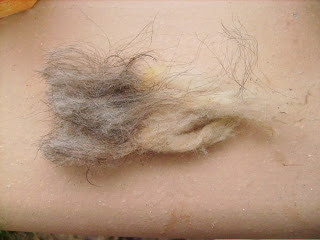
New colourway "Baby Lochness" on North Ronaldsay blend tops
What an exciting week : lots and lots of dyeing, new blends, spinning and making stitchmarkers plus the February club! It’s all happening !
This weekend I will be posting all the info and the teaser label of the February club..should have done that sooner, but as usual I’m running out of time…all the time…lol
Btw, The Club sign ups are open on the IxCHeL shop. The New Art Journey clubs are starting up again in April 2024 with loads and loads more inspirational art works translated onto yarn and fibres. Please let me know if you have any questions about the clubs or if you would like to have a combination of either yarn and fibre or all three types of the clubs: yarn, batt and fibre club or if you would like all three month’s clubs sent together to save you on shipping, especially when you are overseas so you save on shipping costs.
Now, what is NEW this week? A freshly blended and dyed Rare Sheep Breed blend !
Today's update is all about a very special rare breed sheep on the Scottish Isle of North Ronaldsay.
The North Ronaldsay Sheep are the only animals in the world, aside from a certain Galapagos lizard, to be able to subsist entirely on seaweed, leading to its nickname ‘seaweed sheep’. The breed is thought to be over 5000 years old. The breed is farmed within the Northern Ronaldsay Islands, Orkney and kept nearby the seashore for most of the year. In 1832 the Laird of North Ronaldsay decided that his pastureland should not be wasted on native sheep and a dyke was built round the island to keep them on the shore and off the land. It was most probably this separation that resulted in the preservation of the North Ronaldsay, as it prevented cross breeding which had been the downfall of other Orkney sheep.
The North Ronaldsay is one of the Northern Short tailed primitive group of breeds that also includes the Manx Loghtan, Soay, Shetland and Icelandic . The North Ronaldsay is still mainly found on its native island, the northernmost of the Orkneys. The sheep keeping system on North Ronaldsay is unique and involves a stone wall which keeps the sheep on the seashore and away from the cultivated land for most of the year. This wall was built in 1832 and since then the breed has evolved to survive primarily on seaweed. The sheep live on the seashore most of the year around and are only brought onto the better land for lambing.
The North Ronaldsay is one of group of primitive Northern Short-tailed sheep and represents a very early stage in the evolution of domestic sheep. DNA studies have shown a close relationship to sheep found in the Stone Age village of Skara Brae on mainland Orkney, which dates from 3000 BC. In 1832 a wall was built around their native island to confine the animals to the foreshore for most of the year in order to conserve the inland grazing. Since then the breed has developed its distinctive metabolism due to its diet of seaweed, which also renders it susceptible to copper poisoning under standard sheep management systems. North Ronaldsays are very sensitive to copper and will die of copper toxicity if put on the wrong type of grazing. This is due to their seaweed diet and the unique metabolism they have evolved. They should not be fed commercial sheep mixes as despite the label saying “No Added Copper” the normal ingredients used will often have a background level high enough to be toxic (ten parts per million is too high). The North Ronaldsay is capable of surviving on less than larger breeds and is an active browser, used to ranging over long distances in search of food.
Colours of their fleece are variable: including white, various shades of grey, black and moorit (deep brown). The double fleece has coarse outer guard hairs and a fine soft inner coat. I have never ever felt and dyed something as extraordinary as this sheeps fleece. It is springy, almost feels moist even after its scouring and washing. It almost feels like it resists the dye when you pour the pigments on and everything immediately flows to the bottom, leaving the top layer of the fibre springy and almost without dye. At least, that is what appears to happen…it takes the dye beautifully and retains its springy texture and openness.
Before dyeing and spinning though was the rather painful process of getting rid of the guardhairs ! Here’s a view of the raw fleece :

After all of the cleaning and carding and blending you get what I am offering you today !
It is a dream to spin and work with. You can make a yarn that is strong and still soft to wear. It is very very special ! There are only about 600 of these seaweed sheep left in the world. Only through our effort of conservation of the environment and conservation through appreciation of this rare breed by spinning and knitting its fleece, can we hold on to one of the oldest and most special breeds in the world alive today.
You can check everything out in the what's new section on the IxCHeL shop by clicking here.
Have a fantastic weekend filled with lots of creative fibre fun !
Big hugs,
Charly




No comments:
Post a Comment